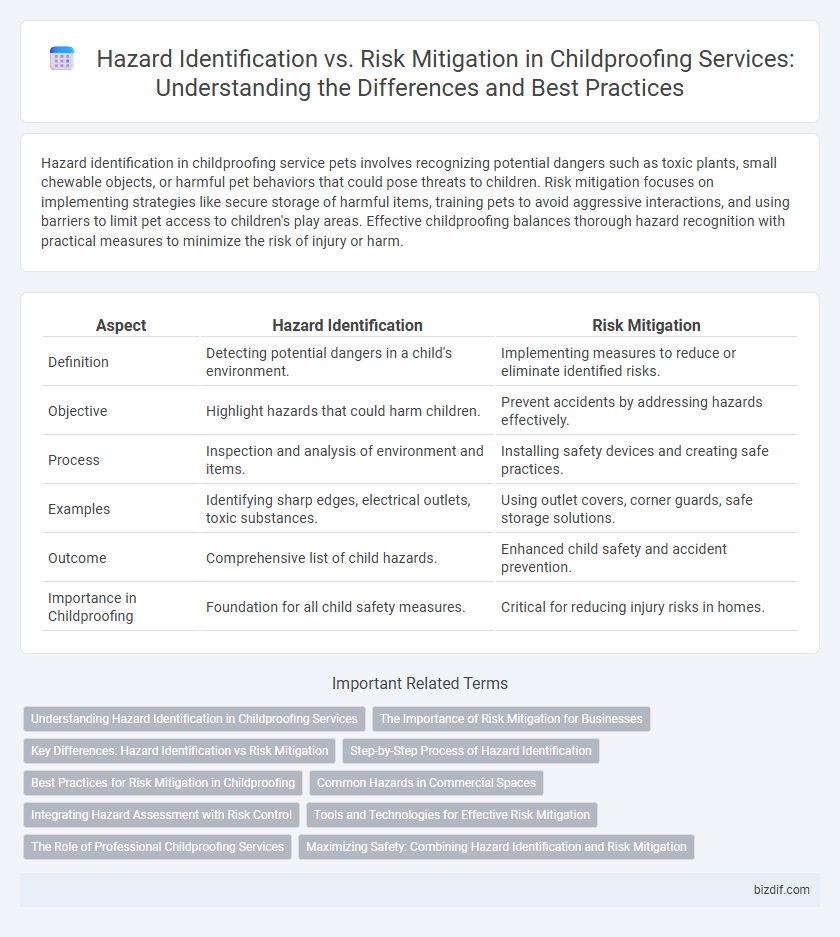Hazard identification in childproofing service pets involves recognizing potential dangers such as toxic plants, small chewable objects, or harmful pet behaviors that could pose threats to children. Risk mitigation focuses on implementing strategies like secure storage of harmful items, training pets to avoid aggressive interactions, and using barriers to limit pet access to children's play areas. Effective childproofing balances thorough hazard recognition with practical measures to minimize the risk of injury or harm.
Table of Comparison
| Aspect | Hazard Identification | Risk Mitigation |
|---|---|---|
| Definition | Detecting potential dangers in a child's environment. | Implementing measures to reduce or eliminate identified risks. |
| Objective | Highlight hazards that could harm children. | Prevent accidents by addressing hazards effectively. |
| Process | Inspection and analysis of environment and items. | Installing safety devices and creating safe practices. |
| Examples | Identifying sharp edges, electrical outlets, toxic substances. | Using outlet covers, corner guards, safe storage solutions. |
| Outcome | Comprehensive list of child hazards. | Enhanced child safety and accident prevention. |
| Importance in Childproofing | Foundation for all child safety measures. | Critical for reducing injury risks in homes. |
Understanding Hazard Identification in Childproofing Services
Hazard identification in childproofing services involves systematically recognizing potential dangers within a home environment, such as sharp edges, toxic substances, or accessible electrical outlets. This process prioritizes pinpointing specific safety threats that could harm children, forming the foundation for effective prevention strategies. Understanding hazard identification enables professionals to tailor childproofing solutions that directly address the unique risks in each household.
The Importance of Risk Mitigation for Businesses
Risk mitigation is crucial for businesses offering childproofing services as it involves implementing strategies that reduce potential hazards identified during assessments. Effective risk mitigation minimizes the chances of accidents, protects children's safety, and reduces the likelihood of legal liabilities and financial losses. Prioritizing risk mitigation ensures compliance with safety regulations and builds trust with clients, reinforcing the business's reputation and long-term success.
Key Differences: Hazard Identification vs Risk Mitigation
Hazard identification involves recognizing potential sources of harm in a child's environment, such as sharp edges, toxic substances, or unsecured furniture. Risk mitigation focuses on implementing strategies to reduce or eliminate these dangers, like installing corner guards, locking cabinets, and anchoring heavy items. Understanding the key difference highlights that hazard identification is about detecting risks, whereas risk mitigation is about proactively managing and controlling those risks to ensure child safety.
Step-by-Step Process of Hazard Identification
The step-by-step process of hazard identification in childproofing service involves systematically inspecting environments such as homes or daycare centers to detect potential dangers like sharp edges, toxic substances, or unsecured furniture. This process includes categorizing hazards by severity and likelihood to prioritize risks effectively. Accurate hazard identification forms the foundation for targeted risk mitigation strategies that ensure child safety.
Best Practices for Risk Mitigation in Childproofing
Effective childproofing relies on thorough hazard identification to pinpoint potential dangers such as sharp edges, choking hazards, and toxic substances. Implementing best practices for risk mitigation includes installing safety gates, securing furniture to walls, and using outlet covers to prevent electrical shocks. Regularly updating safety measures and educating caregivers further enhances protection, creating a safer environment for children.
Common Hazards in Commercial Spaces
Hazard identification in commercial spaces involves recognizing common dangers such as exposed electrical outlets, slippery floors, and sharp furniture edges that pose threats to children's safety. Risk mitigation focuses on implementing measures like installing outlet covers, applying non-slip mats, and padding corners to reduce potential accidents. Effective childproofing services combine thorough hazard assessments with targeted solutions to create safer environments for children in business settings.
Integrating Hazard Assessment with Risk Control
Integrating hazard assessment with risk control enhances childproofing effectiveness by systematically identifying potential dangers and implementing targeted safety measures. This approach prioritizes early detection of hazards such as sharp edges, toxic substances, and electrical outlets while deploying tailored solutions like protective covers and secure storage. Combining thorough hazard identification with proactive risk mitigation ensures safer environments that significantly reduce incidents of childhood injuries.
Tools and Technologies for Effective Risk Mitigation
Hazard identification involves detecting potential dangers in the home environment, such as sharp edges, toxic substances, or unsecured furniture, through thorough inspections and child safety audits. Risk mitigation employs advanced tools and technologies like safety gates with automatic locking mechanisms, smart monitoring devices, and motion sensors to prevent accidents effectively. Integrating these innovative solutions ensures a comprehensive childproofing strategy that minimizes injury risks and enhances overall child safety.
The Role of Professional Childproofing Services
Professional childproofing services conduct thorough hazard identification by evaluating homes for potential dangers like sharp edges, toxic substances, and unsecured furniture. They implement targeted risk mitigation strategies including installing safety gates, securing cabinets, and using outlet covers to reduce accident risks. Their expertise ensures a safer environment tailored to a child's developmental stage and specific household layout.
Maximizing Safety: Combining Hazard Identification and Risk Mitigation
Maximizing safety in childproofing requires a strategic combination of hazard identification and risk mitigation practices. Hazard identification systematically uncovers potential dangers such as sharp edges, toxic substances, and unstable furniture, while risk mitigation involves implementing tailored solutions like corner guards, secure locks, and furniture anchors to reduce incident likelihood. This integrated approach ensures a comprehensive child safety environment by proactively addressing hazards and minimizing risks.
Hazard identification vs Risk mitigation Infographic

 bizdif.com
bizdif.com